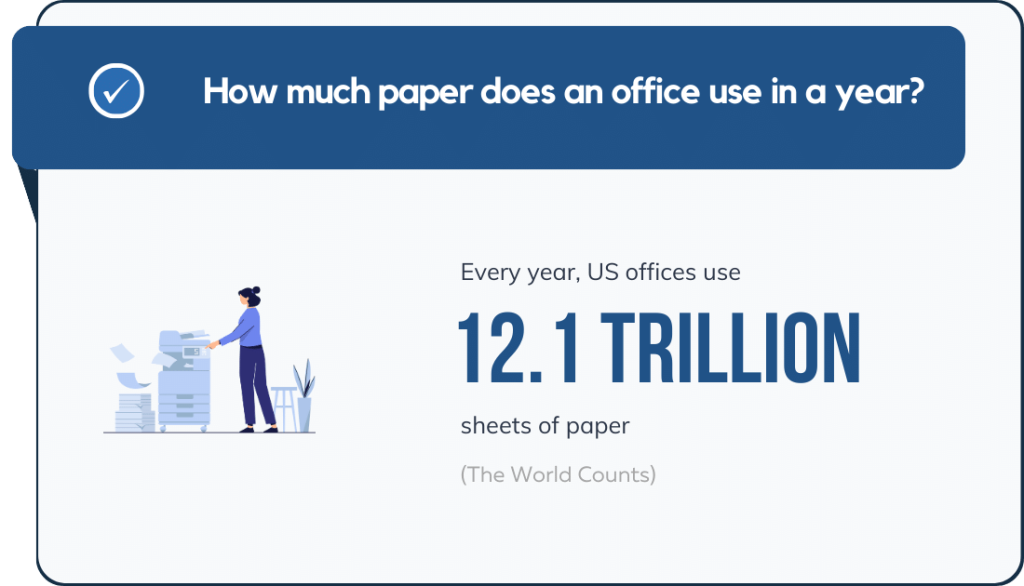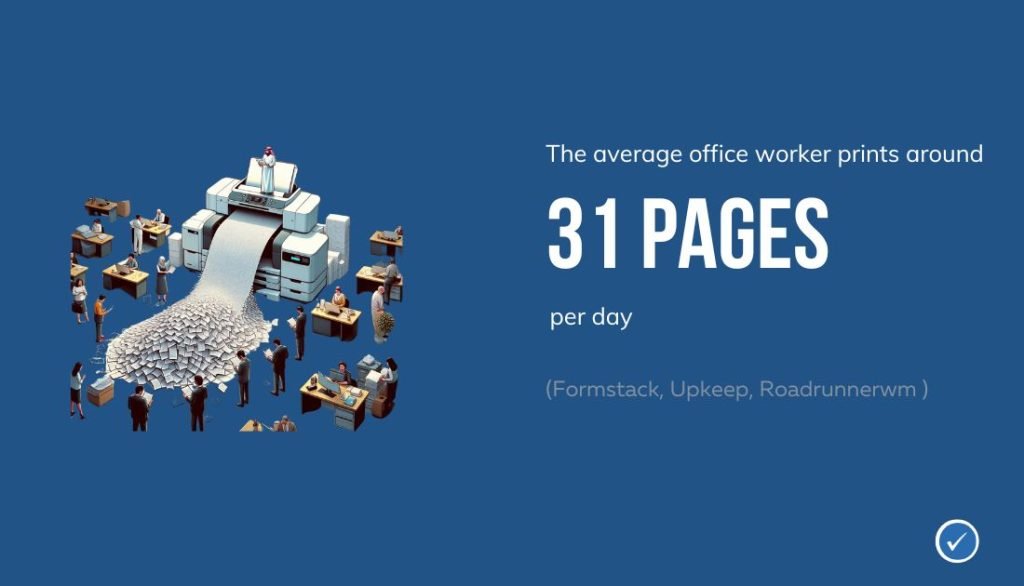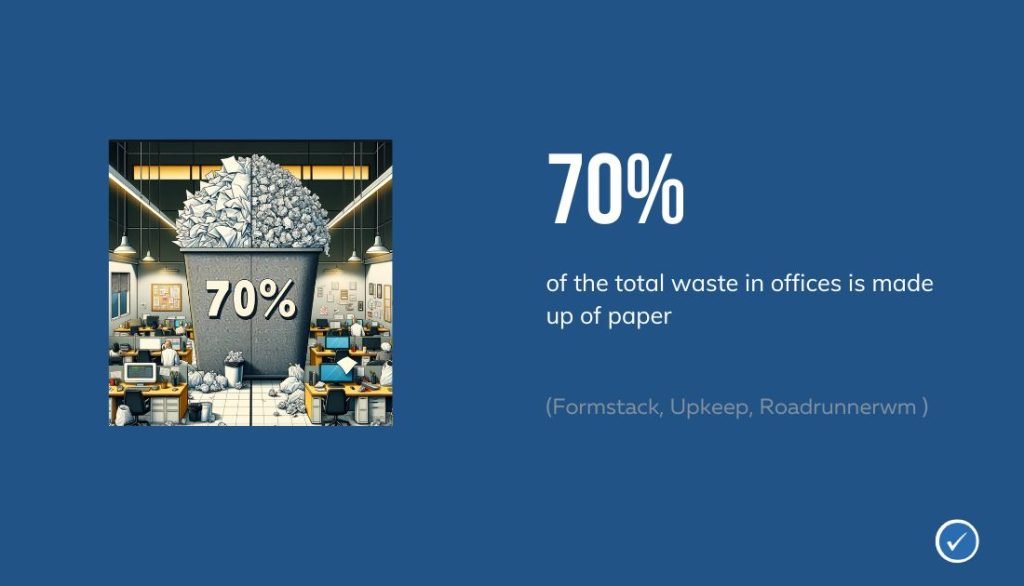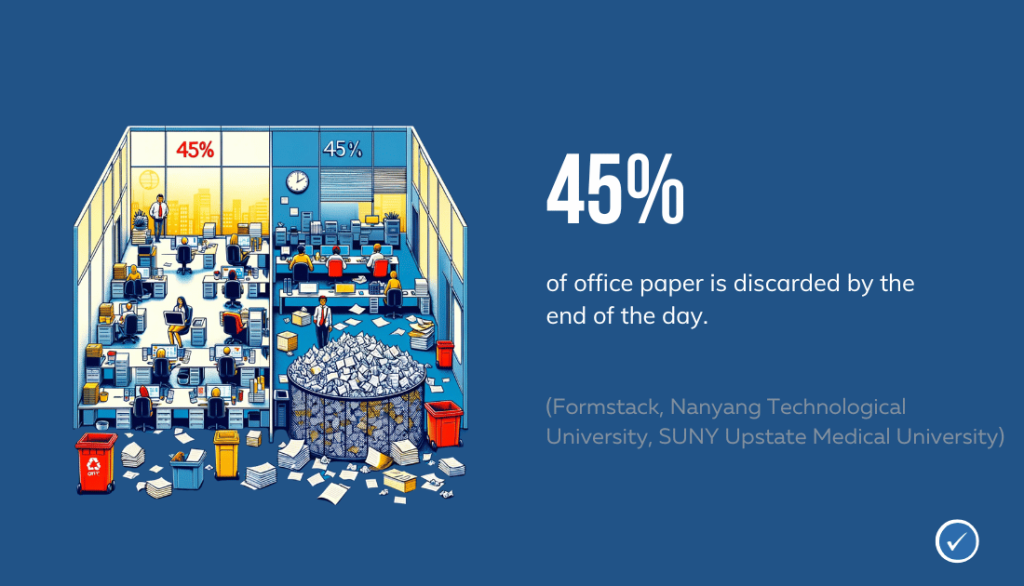Over the past 40 years, worldwide paper consumption has escalated dramatically, increasing by 400%. This surge is vividly reflected in the daily routines of office environments, where the average worker contributes to this trend by printing around 31 pages per day.
Despite the digital revolution, a surprising 93% of business information continues to be produced on paper, underscoring the persistent reliance on this traditional medium. Annually, this culminates in the production of an astonishing 21 million tons of paper waste by American businesses, a figure that not only highlights the extensive use of paper in professional settings but also signals significant environmental and resource implications.
Let me share the most crucial office paper consumption statistics and general data you should be aware of right away. 🌍📉🌳
Office Paper Consumption Statistics: The Key Data
- Every year, US offices use 12.1 trillion sheets of paper.
- The average American office worker uses 10,000 sheets of office paper per year.
- The average office worker prints around 31 pages per day.
- 70% of the total waste in offices is made up of paper.
- American businesses use approximately 21 million tons of paper per year, with approximately 750,000 copies made every minute.
- On average, businesses lose 7.5% of all paper documentation.
- 45% of office paper is discarded by the end of the day.
- 76% of office workers admit to printing non-work documents at work, with 6% doing so on a daily basis.
Sources: (The World Counts, University of Illinois Urbana-Champaign, Wikipedia, Upkeep, RoadRunner Recycling, St. Charles County, CamScanner, Environmental Paper Network, Cartridgesave
Paper Waste Facts in General
- To produce one ton of paper, twenty-four trees are needed.
- Annually, 85 million tons of paper waste are produced.
- Every year, approximately 1 billion trees worth of paper are discarded in the United States.
- Paper accounts for 25% of landfill waste and 33% of municipal waste.
- Over 40% of all wood pulp is used to make paper.
Sources: (WorldAtlas, St. Charles County, Florida Institute of Technology, Mr. Rooter, University of Illinois Urbana-Champaign
How much paper does an office use in a year?
According to research, the average office worker in the U.S. uses a staggering 12.1 trillion sheets of paper annually in U.S. offices. Shockingly, around 45% of the paper printed in offices ends up being thrown away by the end of each day.

Paper usage, copying, storage, and waste cost companies billions per year. Reducing paper consumption through digitization and efficient practices could significantly cut costs and environmental impacts. Overall, offices continue to use vast amounts of paper despite technological advances, resulting in high financial and environmental costs.
Source: The World Counts
How much paper does the average office worker use a year?
The average office worker uses a staggering amount of paper each year – around 10,000 sheets, or two pounds per day. Despite advances in technology, paper consumption and waste remains high. Nearly half of all printed documents are discarded within 24 hours. This adds up to 70% of total office waste.

There are many ways organizations can reduce paper usage, such as printing double-sided, sending electronic instead of paper bills and forms, and minimizing printing. Doing so would significantly cut costs and environmental impact. Transitioning to digital processes is key for a paperless, eco-friendly office.
Source: University of Illinois Urbana-Champaign
How much does an average office worker print per day?

The average office worker prints about 10,000 pages per year, which comes out to around 31 pages per day. However, a significant portion of this printing is considered wasted – around 17% of pages printed daily go unused. Unnecessary printing wastes paper and drives up costs, with printing expenses being a top operating cost for many companies.
Steps can be taken to reduce wasted printing, like setting print quotas, previewing print jobs, and minimizing personal printers. Overall, while printing remains common in offices, more mindful printing habits could lead to reductions in unnecessary printing waste.
Source: Wikipedia
What percentage of waste is paper in an office?

Paper waste makes up a significant portion of the total waste generated in offices. Studies show that paper accounts for around 70% of total office waste. This includes copy paper, junk mail, handouts, and other paper products used on a daily basis. With the average office worker using 10,000 sheets of paper per year, paper waste adds up quickly.
Simple steps like printing double-sided, reusing scrap paper, and switching to digital processes can greatly reduce the amount of paper waste produced in an office environment. Reducing paper usage not only decreases waste, but also saves money on supplies and storage.
Source: Upkeep
Office Paper’s Short Life: Discarded Within a Day
| Insights from Statistics | Brief Explanation |
| High Rate of Paper Consumption in Offices | Half of the office paper is used and discarded quickly, indicating inefficient use or over-reliance on paper. |
| Potential for Digital Transition | This rapid consumption suggests a strong potential for digital alternatives to reduce paper waste. |
| Need for Better Paper Management Strategies | The statistic points towards a necessity for strategic planning in paper usage to minimize waste. |
Source: RoadRunner Recycling
American Business: A Paper-Heavy Operation
| Insights from Statistics | Brief Explanation |
| Immense Scale of Paper Usage in Business | The sheer volume of paper use suggests a significant environmental impact and a need for efficient usage strategies. |
| Opportunity for Sustainable Practices | With such high consumption, there’s a substantial opportunity to implement eco-friendly practices in paper usage. |
| Potential for Reducing Paper Dependency | The frequency of copying implies possible over-reliance on physical documentation, suggesting a shift towards digital means could be beneficial. |
Source: St. Charles County
Document Disappearance: Companies Losing Vital Paperwork
| Insights from Statistics | Brief Explanation |
| Inefficiency in Paper Record Management | The loss of 7.5% of documents indicates inefficiencies in traditional paper filing systems. |
| Increased Risk of Information Mismanagement | Such a loss rate poses risks of mismanagement and information security concerns. |
| Need for Digital Documentation Systems | This statistic underscores the potential benefits of transitioning to digital document management systems. |
Source: CamScanner
Daily Paper Waste: Office Printouts Not Spared

| Insights from Statistics | Brief Explanation |
| High Level of Daily Paper Waste | Nearly half of the paper used in offices is thrown away daily, indicating substantial wastage. |
| Opportunity for Improved Paper Utilization | This high waste rate suggests a need for better utilization strategies for office paper. |
| Potential for Enhanced Recycling Efforts | The volume of paper discarded daily highlights the importance of effective recycling practices in offices. |
Source: Environmental Paper Network
Workplace Printing Habits: Not All Business
| Insights from Statistics | Brief Explanation |
| High Incidence of Non-Work Printing | A large majority using work resources for personal printing suggests a need for clearer workplace policies. |
| Daily Misuse of Office Resources | The daily printing of non-work documents by a small percentage indicates habitual misuse of office resources. |
| Potential for Policy and Ethical Training | This trend underscores the importance of training and policies on the ethical use of office resources. |
Source: Cartridgesave
How many trees does it take to make 1 ton of paper?
Industry experts estimate that around 24 trees are needed to produce 1 ton of printing and writing paper using the chemical pulping process. This is based on a mix of softwood and hardwood trees, each around 40 feet tall with a 6-8 inch diameter. In comparison, the mechanical pulping process used for newsprint is more efficient, requiring only about 12 trees per ton.
Overall, the number of trees required depends on factors like tree size, pulp process, and paper quality. But it’s clear that a substantial amount of trees are consumed to satisfy global paper demand, highlighting the importance of paper recycling and conservation.
Source: WorldAtlas
How many tons of paper are wasted each year?
Americans generate a staggering amount of paper waste each year. Studies show that the average American uses over 700 pounds of paper annually. In total, around 85 million tons of paper are wasted each year in the U.S. alone. Shockingly, paper accounts for a full 25% of waste in landfills and 33% of municipal waste.
Much of this waste is avoidable, as Americans consume huge amounts of disposable paper products like toilet paper, paper towels, and junk mail. Simple actions like recycling, buying recycled products, and reducing paper usage can make a real dent in paper waste. If every American reduced their paper consumption even slightly, millions of trees and tons of resources could be saved.
Source: St. Charles County
The Tree Toll: America’s Paper Waste Reality
| Insights from Statistics | Brief Explanation |
| Massive Environmental Impact of Paper Waste | The discarding of such a large volume of paper points to a substantial environmental footprint. |
| Urgency for Sustainable Paper Usage | This statistic emphasizes the critical need for sustainable and responsible paper consumption. |
| Potential for Increased Recycling and Reuse Efforts | The high volume of paper waste suggests a significant opportunity for enhanced recycling and reuse practices. |
Source: Florida Institute of Technology
Paper: A Significant Contributor to Landfill Waste
| Insights from Statistics | Brief Explanation |
| Significant Contributor to Landfill Waste | Paper makes up a substantial portion of landfill waste, indicating a major area for waste reduction efforts. |
| Major Role in Municipal Waste | The high percentage of paper in municipal waste highlights the need for improved recycling and reduction strategies. |
| Opportunity for Waste Management Improvements | This statistic underscores the potential for enhancing waste sorting, recycling, and reduction initiatives. |
Source: Mr. Rooter
Wood Pulp for Paper: An Overlooked Resource Drain
| Insights from Statistics | Brief Explanation |
| High Demand for Paper Affecting Forestry | The large proportion of wood pulp used for paper indicates a significant impact on forest resources. |
| Need for Sustainable Forestry Practices | This statistic underscores the importance of sustainable forestry to balance the demand for paper. |
| Potential for Alternative Raw Materials | The high usage of wood pulp for paper suggests exploring alternative, more sustainable raw materials. |